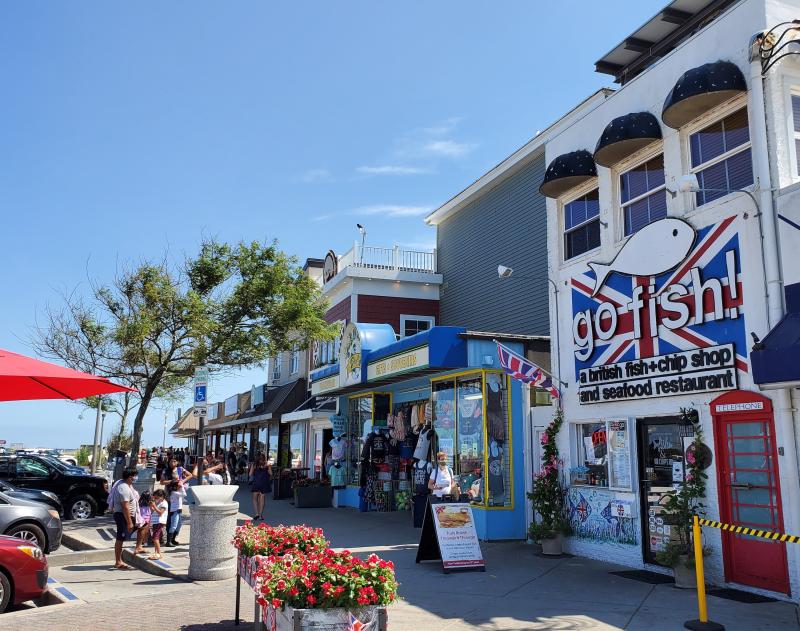With environmentally sustainable infrastructure on the roof and ground-level commercial space, the proposed Belhaven Hotel project in Rehoboth Beach is now being pitched by its development team as a demonstration for how future construction in the city could look.
During a special Rehoboth Beach Planning Commission meeting Aug. 21, Peter Fillat, project architect, said there is no code in Rehoboth Beach calling for projects to be LEED certified or for mixed-use, but many cities do support those things, and the Belhaven could be used as an example for future development within the city.
First introduced in 2019, the proposed Belhaven Hotel last came before the planning commission in June. That hotel design was a code-compliant structure that didn’t appeal to anyone on the planning commission or the development team, because it didn’t have any architectural significance and it featured a parking garage on the ground floor fronting the Boardwalk.
At the time, property owner John Papajohn said it looked like a Motel 6, which was not a compliment.
During the workshop, Fillat presented to the planning commission a four-story structure with an underground parking garage. There were a hotel lobby and commercial space on the ground level; hotel rooms, conference center and pool on the second floor; and hotel rooms on the third and fourth floors. Topping the structure, he said, would be solar panels, agricultural green space the hotel restaurant could use, and possibly a greenhouse.
Fillat said the top areas of the hotel would only be open to hotel staff and restaurant employees, which means the design would not trigger a variance request.
As presented, the building would be 42 feet tall, with a 15-foot-tall structure on top of the roof to house the elevator mechanism. Fillat said city code allows for building infrastructure to broach the city’s 42-foot height limit.
Including underground parking, all the enclosed commercial space, pool deck, balconies, conference center and a few other items, the proposed structure would have a floor-to-area ratio of 3.28. The city’s code allows for a FAR of 2.
Fillat said the hotel would have 110 rooms, with 124 parking spaces. According to information packets provided for the meeting, the total square footage, underground garage included, is roughly 148,000 square feet.
In addition to exceeding FAR, the project exceeds allowable lot coverage. Fillat explained that code allows for 100 percent lot coverage on the ground level and then 50 percent lot coverage for the three additional floors. As proposed, the first floor would have the allowable 100 percent lot coverage; the second floor would have 95 percent lot coverage, with 50 percent toward hotel space, 34 percent toward balconies and a terrace, and 20 percent toward a conference center; the third and fourth floors would each have 56 percent coverage, with 50 percent toward hotel space and 6 percent toward balconies.
The whole discussion at the special meeting was based on the project getting a modification of the flood plain map. Currently, a small section of the northeast portion of the property, near the Boardwalk and Rehoboth Avenue, is in a VE zone of the Federal Emergency Management Agency’s Flood Insurance Rate Maps. According to FEMA, buildings in this zone are at a higher risk of flooding than other buildings, and underground parking is not allowed when residential space is above; hotel rooms are considered residential space.
Alex Papajohn, son of John, said the family has hired an engineering firm to help them work through the map-revision process with FEMA. He said he’s been told by the engineer there’s a good chance the map will be revised to say the property is in zone X, which is considered to have minimal risk of flooding.
Alex said the family started the process in early August by submitting the change request to the city. He said he’s hopeful the city will support the change, and once that happens, there will be an official submission to FEMA. He said he expects the process to take up to three months.
Fillat said they were confident in the request because there have been significant improvements made to the dune infrastructure over the past few decades.
Public comment was limited during the special workshop, but there was some – primarily by neighbors with property abutting the project.
Alison Blyth, owner of Go Fish!, said Rehoboth Beach definitely needs a shot of vibrancy, but this year has been especially difficult and she’s concerned what a project of that magnitude would do to her business. As proposed, the western edge of the new hotel would basically be right next to her building, with no space in between.
The noise and the loss of business makes it difficult to plan for the future, she said, adding that the solar panels on the top of her building and the windows of her rental space above the restaurant would also be affected.
Blyth recognized the Papajohns’ long history in the city, but she said she has a strong two-decade history herself in Rehoboth Beach. Go Fish! is a woman-owned business that’s one of the most photographed buildings in town, she said.
Blyth said she also had concerns about the project having two restaurants – one in the hotel and Grotto Pizza, which is currently a tenant fronting the Boardwalk. Restaurants are all fighting for the same customers, she said.
Long gone are the days when restaurants could make enough money during the summer season to pay for a year’s worth of bills, said Blyth.
Dr. Michael Trahos, cousin to the Papajohns and property owner of the parcel fronting the Boardwalk and Wilmington Avenue that would be surrounded by the proposed hotel, said he wasn’t against the redevelopment of the property, but he continued to raise concerns he’s had from the beginning. Among them were how underground parking could affect the structural integrity of his property because of an increased risk of subterranean hydrostatic pressure, and how the project didn’t have enough emergency access points for fire apparatus to reach a fire in the core of the building without using the roof of his property as the primary access.
At the end of the meeting, planning commission members said they like the new design much better than the code-compliant version, but they recognized there were still some issues to be worked out.
Fillat said the hotel was still in the early stages of the design process, but he and the Papajohns were looking for a show of support for what was presented.
Chris Flood has been working for the Cape Gazette since early 2014. He currently covers Rehoboth Beach and Henlopen Acres, but has also covered Dewey Beach and the state government. He covers environmental stories, business stories and random stories on subjects he finds interesting, and he also writes a column called Choppin’ Wood that runs every other week. He’s a graduate of the University of Maine and the Landing School of Boat Building & Design.












































